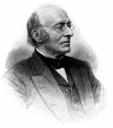Part 2: His True Calling
Douglass worked for the Anti-Slavery Society for many years. He traveled to many states, giving lectures and speaking firsthand about the evils of slavery. After a time, people began to doubt the sincerity of his stories. How could this man who spoke with such big words and such high-minded concepts have been a slave just a short time ago? To answer these charges, Douglass published his life story, Narrative of the Life of Frederick Douglass, an American Slave. Thousands of people bought this book, and Douglass's popularity grew even more. Satisfied that his reputation had been restored, Douglass then went to England, where he spent two years traveling the countryside, giving lectures. He made important friends in England, who helped him buy his freedom. Frederick Douglass returned to the United States in 1847 as a free man. He moved to Rochester, New York, and began publishing a newspaper, the North Star. The newspaper's motto was this: "Right is of no sex - Truth is of no color - God is the Father of us all, and we are all Brethren."
Next page > Great Successes > Page 1, 2, 3 |
|
Social Studies for Kids
copyright 2002–2024
David White

 Douglass
was a passionate promoter of the abolition of slavery. Having been a slave himself, he knew firsthand the horrors that those still in bondage were experiencing and wanted those horrors to end. He became involved in the
Douglass
was a passionate promoter of the abolition of slavery. Having been a slave himself, he knew firsthand the horrors that those still in bondage were experiencing and wanted those horrors to end. He became involved in the  Douglass
continued to fight for the freedom of slaves. He also took
up the cause of women's suffrage. At that time, women
couldn't vote. Douglass met Lucretia Mott, Susan B. Anthony,
and other leaders of the women's suffrage movement.
Douglass
continued to fight for the freedom of slaves. He also took
up the cause of women's suffrage. At that time, women
couldn't vote. Douglass met Lucretia Mott, Susan B. Anthony,
and other leaders of the women's suffrage movement.

